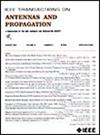94/237 GHz等波束宽度双波段反射天线,用于气象雷达
IF 5.8
1区 计算机科学
Q1 ENGINEERING, ELECTRICAL & ELECTRONIC
引用次数: 0
摘要
本文提出了一种工作在94/237 GHz波段的全金属双频偏馈抛物面反射器天线,用于气象雷达应用。双频喇叭馈线由两个波导、一个低通滤波器、一个多模转换和一组环形波纹组成。滤波器用于分离94/237 GHz信号。采用多模跃迁和波纹产生铅笔束,也可以改变两个波段的相位中心位置。为了实现94 GHz和237 GHz等波束宽度,对反射面天线的焦点进行了优化,对237 GHz波束宽度进行了加宽。制作了双频天线样机并进行了测量。测量带宽可覆盖90.4 ~ 96.6 GHz和220 ~ 250 GHz。内部近场平台测得的3db波束宽度在94 GHz时约为0.57°,在237 GHz时约为0.54°。在两个频带内实现了准等波束宽度。本文章由计算机程序翻译,如有差异,请以英文原文为准。
94/237 GHz Dual-Band Reflector Antenna With Equal Beamwidth for Weather Radar Applications
In this article, a fully metallic dual-band offset-fed parabolic reflector antenna operating at 94/237 GHz bands is proposed for weather radar applications. The dual-band horn feeder consists of two waveguides, a low-pass filter, a multimode transition, and a set of annular corrugations. The filter is used to separate the 94/237 GHz signals. The multimode transition and the corrugations are adopted to generate pencil beams, which can also change the position of phase center in the two bands. In order to achieve equal beamwidth at 94 and 237 GHz, the focal point of the reflector antenna is optimized, and the beamwidth at 237 GHz can be broadened. A prototype of the dual-band antenna is fabricated and measured. The measured bandwidth can cover 90.4–96.6 and 220–250 GHz. The 3-dB beamwidth measured by the in-house near-field platform is about 0.57° at 94 GHz and is about 0.54° at 237 GHz. Quasi-equal beamwidth is achieved in the two frequency bands.
求助全文
通过发布文献求助,成功后即可免费获取论文全文。
去求助
来源期刊
CiteScore
10.40
自引率
28.10%
发文量
968
审稿时长
4.7 months
期刊介绍:
IEEE Transactions on Antennas and Propagation includes theoretical and experimental advances in antennas, including design and development, and in the propagation of electromagnetic waves, including scattering, diffraction, and interaction with continuous media; and applications pertaining to antennas and propagation, such as remote sensing, applied optics, and millimeter and submillimeter wave techniques

 求助内容:
求助内容: 应助结果提醒方式:
应助结果提醒方式:


